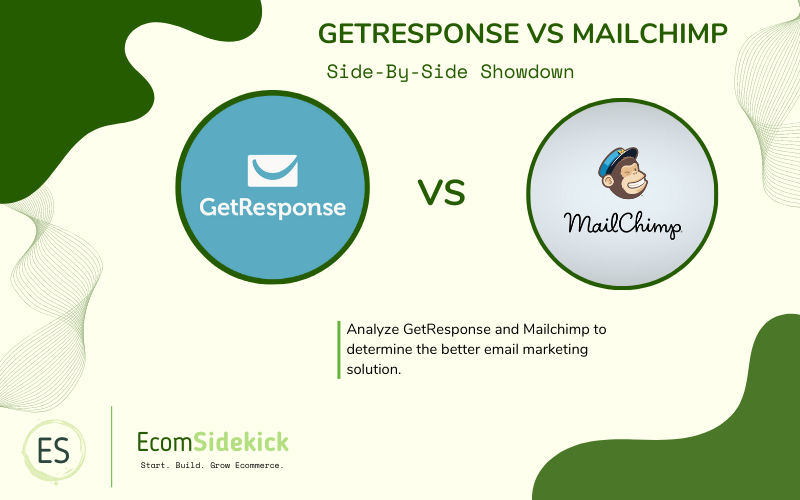If you’re looking for newsletter and email marketing services, you’ve undoubtedly noticed that MailChimp and GetResponse are two of the most popular options. Both services are excellent choices, but it’s essential to understand some of the critical differences between these email marketing tools.

Along with marketing platforms, you also want to understand the various types of ecommerce.
Now, read on as we compare these two services across several categories, including price, features, ease of use, and customer support. It’s the final showdown: GetResponse vs MailChimp. Which one is better?
About GetResponse
GetResponse is a comprehensive marketing platform that more than 350,000 users in 183 countries use to unleash their marketing by creating landing pages, sales funnels, and email automation.
Features

GetResponse and MailChimp vary primarily because GetResponse is a whole marketing platform, whereas MailChimp is an email marketing platform.
In contrast, GetResponse is a full-service platform for expanding your audience, advertising services, and marketing goods that also has all the characteristics required for email marketing.
- Establishing an online store
- Emails with a responsive design
- Create landing pages that convert well
- Social media marketing tools to increase visitors
- Templates for marketing funnels
Theoretically, you could use one dashboard to develop a shop, market to an email list, create landing pages, and increase traffic to those sites.
GetResponse is a user-friendly email marketing tool that offers a superior user experience.
There is a significant learning curve, so you must find out where everything is and how it works, even though it is an easy-to-use solution once you have it going.
Pros
User-friendly
Excellent customer service experience
Offers superior advertising services
CONS
API could be more robust
About Mailchimp

MailChimp is an email marketing automation software that was established in 2001. You might be able to recognize the logo even if you’ve never used simple email marketing.
MailChimp is essentially the New England Patriots and New York Yankees of the industry: illustrious, prosperous, loved by many people but despised by an even more significant number.
But like those franchises, MailChimp continues to win and only grows in size, power, and wealth. Whether you like them or not, their software has aided virtually every internet firm in achieving rapid growth.
Almost all digital entrepreneurs have leveraged their “freemium” concept to dip a toe into the email marketing field.
Features
What MailChimp offers:
- Tools for designing brands
- Import a set of emails
- Templates for emails and newsletters
- Open rate, clickthroughs, forwards, and other email analytics
- Marketing automation workflows
- Features of social media marketing
MailChimp recently changed and aimed to increase the number of options it offered. Imagine your favorite squad trying out for a different sport.
Many devoted followers have begun to doubt their fandom as a result. Nevertheless, their email marketing service is still excellent.
Because it is so simple to use and doesn’t require any formal training, MailChimp is appropriate for new users.
Gaining actionable knowledge is simple because of its user-friendly analytics. This makes it the perfect option for anyone who wants to approach email marketing with data.
Pros
Various tools to choose from
Ways of social media marketing
Great for beginners
User-friendly analytics
CONS
The interface can be awkward for new users
Similarities Between GetResponse vs Mailchimp
Ease of Use
Both GetResponse and MailChimp perform admirably in terms of usability. Simple design and menu structures make it simple to navigate, and there are just a few minimal issues that won’t bother most users. Both include a straightforward drag-and-drop editor with little complexity.
Automation
Marketing automation is available from both newsletter services. This should enable you to develop routines based on events like email openings and clicks.
A few triggers are available from MailChimp, such as sending emails when a user subscribes, leaves their shopping cart unattended in your shop, or even visits a specific URL on your website.
With the advent of lead scoring, GetResponse also provides extremely comparable choices.
Differences Between GetResponse and Mailchimp
Simplicity
MailChimp is a little simpler if forced to pick only one. The editor in GetResponse might be a bit challenging to use at times.
Design & Flexibility of Templates
There are several options for templates with GetResponse. All of them have excellent designs and a great user interface. It’s pretty simple to modify templates now that they’ve improved their MailChimp email editor and give your newsletter the style you desire.
Email templates from MailChimp don’t have as many options. The only templates included in the free and essential plans are simple ones that are now quite antiquated. All users may utilize GetResponse, which is advantageous, and they’ve introduced some lovely designs.
Testing for Spam & Design
You may test your campaigns with certain email providers to see if there are any difficulties with how they will appear in various email clients. Your emails may occasionally end up in the spam bin due to these problems.
Unless you choose one of their higher plans, MailChimp offers design testing through a third-party firm at an additional expense. Sadly, they provide no spam testing at all.
GetResponse earns all possible points in this round since they provide both as part of their standard plans. You may use the inbox testing service to see how your email will look on various clients.
Additionally, you obtain a spam test score out of five at the last stage of your campaign.
List Maintenance
For certain companies, it might be crucial to have an easy way to transfer subscribers to and from other lists. This also holds for list segmentation based on specific traits. MailChimp works well with simple segmentation techniques, enabling you to combine several favorable or unfavorable circumstances, e.g., clicking on email links.
However, you can’t manage subscribers across lists because each list is separate.
On the other hand, GetResponse supports far more intricate list administration. You can relocate contacts or copy them to other email marketing campaigns because the lists are not categorized.
As you may apply any/all conditions to users and groups, segments are more flexible. For the reasons stated above, GetResponse comfortably prevails in this contest.
Languages
If multilingual accessibility is required, then this choice should be obvious. MailChimp is exclusively in English, even though Spanish-language help is offered.
While GetResponse’s website supports up to 17 languages, making it the apparent victor in this contest. The only issue is that some translations, such as those into German and Spanish, should be improved.
Pricing
At the lower end, the two providers’ prices diverge significantly. Although both provide a forever-free plan, the limits vary greatly.
GetResponse offers 500 subscribers but has no email restriction, whereas MailChimp restricts you to 2,500 emails and 500 subscribers each month. Both MailChimp and GetResponse lack sophisticated functionality, e.g., multistep marketing automation.
These free plans give access to email marketing companies’ services and more excellent features before signing up, although some free email marketing platforms have more generous budgets.
GetResponse charges $19 per month for just 1,000 subscribers for premium plans. You’ll need to purchase the higher-tier packages to access the advanced services, including webinars and additional marketing automation capabilities.
GetResponse narrowly prevails in this contest. The free plan’s unlimited email capacity is enticing, and their pricier plans are just a little more inexpensive.
GetResponse |
| |
Mailchimp |
|
Our Pick
Both MailChimp and GetResponse are excellent online marketing tools and offer above-par services. More or less, the choice between the two boils down to your personal preference. However, we felt that GetResponse takes a slight edge over MailChimp in terms of usability and the services it offers. Alternatively, MailChimp charges you according to the number of emails you send.
Final Thoughts
Here, GetResponse consistently outperforms MailChimp. By our criteria, it is the undisputed champion.
The more significant subscriber numbers provide a good range of features for a fair price. MailChimp impresses with its user-friendly interface, powerful automation, and extensive email marketing features, firmly establishing itself as the winner in email marketing platforms.
Frequently Asked Questions (FAQs)
What Are Getresponse and Mailchimp, and How Do They Compare as Email Marketing Platforms?
GetResponse and Mailchimp are both popular email marketing platforms that allow businesses to create and manage email campaigns. GetResponse is known for its powerful automation capabilities, while Mailchimp offers a user-friendly interface and a wide range of integrations.
Which Platform Is Better for Beginners in Email Marketing: Getresponse or Mailchimp?
Both platforms are beginner-friendly, but Mailchimp is often considered more user-friendly for beginners due to its intuitive drag-and-drop editor and straightforward design. GetResponse, on the other hand, may offer more advanced features that suit businesses looking to scale their email marketing efforts.
Are There Any Significant Differences in Pricing Between Getresponse and Mailchimp?
Both platforms offer tiered pricing plans, and the cost will depend on the size of the subscriber list and the features needed. Mailchimp offers a free plan with limited features, while GetResponse has a free trial period but does not have a permanent free plan.
Can Getresponse and Mailchimp Handle Different Sizes of Email Subscriber Lists?
Yes, both platforms can handle different sizes of email subscriber lists. They offer scalable plans to accommodate businesses of all sizes, from small startups to large enterprises.
How Do the Automation Features Compare Between Getresponse and Mailchimp?
GetResponse is often praised for its advanced automation features, which allow businesses to create sophisticated and personalized workflows. Mailchimp also offers automation, but it may not be as extensive as what GetResponse provides.
Paul Martinez is the founder of EcomSidekick.com. He is an expert in the areas of finance, real estate, eCommerce, traffic and conversion.
Join him on EcomSidekick.com to learn how to improve your financial life and excel in these areas. Before starting this media site, Paul built from scratch and managed two multi-million dollar companies. One in the real estate sector and one in the eCommerce sector.



